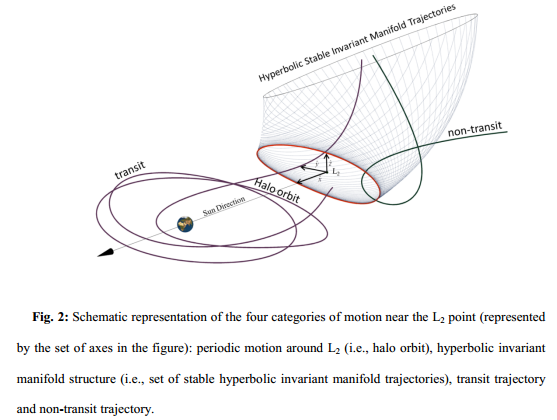Asteroids and comets are of strategic importance for science in an effort to understand the formation, evolution and composition of the Solar System. Near-Earth Objects (NEOs) are of particular interest because of their accessibility from Earth, but also because of their speculated wealth of material resources. The exploitation of these resources has long been discussed as a means to lower the cost of future space endeavours. In this paper, we consider the currently known NEO population and define a family of so-called Easily Retrievable Objects (EROs), objects that can be transported from accessible heliocentric orbits into the Earth’s neighbourhood at affordable costs. The asteroid retrieval transfers are sought from the continuum of low energy transfers enabled by the dynamics of invariant manifolds; specifically, the retrieval transfers target planar, vertical Lyapunov and halo orbit families associated with the collinear equilibrium points of the Sun-Earth Circular Restricted Three Body problem. The judicious use of these dynamical features provides the best opportunity to find extremely low energy Earth transfers for asteroid material. A catalogue of asteroid retrieval candidates is then presented. Despite the highly incomplete census of very small asteroids, the ERO catalogue can already be populated with 12 different objects retrievable with less than 500 m/s of Δv. Moreover, the approach proposed represents a robust search and ranking methodology for future retrieval candidates that can be automatically applied to the growing survey of NEOs.
The possibility of capturing a small NEO or a segment from a larger object would be of great scientific and technological interest in the coming decades. It is a logical stepping stone towards more ambitious scenarios of asteroid exploration and exploitation, and possibly the easiest feasible attempt for humans to modify the Solar System environment outside of Earth, or attempt a large-scale macro-engineering project.
This paper has shown that the retrieval of a full asteroid is well within today’s technological capabilities, and that there exists a series of objects with potential to be temporarily captured into libration point orbits. We define these objects as Easily Retrievable Objects (EROs). These are objects whose orbits lie close to a stable hyperbolic invariant manifold such that a small Δv transfer may link the nominal trajectory of the asteroid with an assymptotic trajectory leading to a periodic orbit near the Sun-Earth L1/L2 points. Under certain conditions, these transfers can be achieved with transfers cost below 500 m/s. Indeed, the paper presents a list of 12 EROs, with a total of 25 trajectories to periodic orbits near L2 and 6 near L1 below a cost of 500 m/s, and the number of these objects is expected to grow considerably in the coming years. The lowest cost is of 58 m/s to transfer asteroid 2006 RH120 to a halo southern family with a single burn on 1st February 2021. All the capture transfer opportunities to Earth’s vicinity have been identified for the currently catalogued NEOs during the next 30 years, and enable capture of bodies within 2-5 meters diameter with low propellant costs.
Taking advantage of these transfer opportunities and the unique dynamical characteristics of the identified EROs, the science return of asteroid missions can be greatly improved, and the utilisation of asteroid resources may become a viable mean of providing substantial mass in Earth orbit for future space ventures. Despite the largely incomplete survey of very small objects, the current known population of asteroids provides a good starting platform to begin with the search for easily retrievable objects. With this goal, a robust methodology for systematic pruning of a NEO database and optimisation of capture trajectories through the hyperbolic invariant stable manifold into different types of LPO around L1 and L2 has been implemented and tested.
The proposed method can be easily automated to prune the NEO database on a regular basis, as the number of EROs in orbits of interest is expected to grow with the new efforts in asteroid detection. Any new occurrence of a low-cost candidate asteroid can be optimised to obtain the next available phasing, transfer opportunities and the optimal target LPO.
Moreover, Sun-Earth LPOs can also be considered as natural gateways to the Earth system. Thus, the problem to transfer an asteroid to an Earth or Moon centred orbit can be decoupled into the initial phase of inserting the asteroid into a stable invariant manifold and then providing the very small manoeuvres required to continue the transit into the Earth system. While a method to find optimal LPO capture trajectories and possible targets has been defined in this paper, the transit trajectories can potentially allow the asteroid to move to the Earth-Moon L1/L2 or other locations within cis-lunar space taking advantage of heteroclinic connections between collinear points
If you liked this article, please give it a quick review on ycombinator or StumbleUpon. Thanks

Brian Wang is a Futurist Thought Leader and a popular Science blogger with 1 million readers per month. His blog Nextbigfuture.com is ranked #1 Science News Blog. It covers many disruptive technology and trends including Space, Robotics, Artificial Intelligence, Medicine, Anti-aging Biotechnology, and Nanotechnology.
Known for identifying cutting edge technologies, he is currently a Co-Founder of a startup and fundraiser for high potential early-stage companies. He is the Head of Research for Allocations for deep technology investments and an Angel Investor at Space Angels.
A frequent speaker at corporations, he has been a TEDx speaker, a Singularity University speaker and guest at numerous interviews for radio and podcasts. He is open to public speaking and advising engagements.


